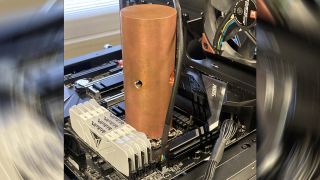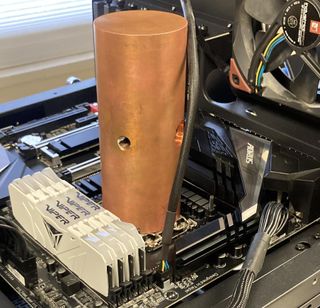DIYer Passive Cools Core i9 with 8-Pound Copper Block
Solid metal cylinder suppressed Core i9 idled at 35C, but quickly reached 80C+ under load.

A humungous passive copper cooling solution has been causing a stir this week in an interesting little corner of Reddit dubbed HardwareGore. According to Redditor ‘That Desktop User’ (TDU), an approximately 8-pound (around 4kg) block of copper can act as a passable passive cooler – even if you are running an Intel Core i9 CPU.
TDU shared a few facts and figures about their solid cylinder of copper cooling escapade, making this makeshift passive option sound almost practical. For the length of a short computing session, an Intel Core i9 (model undisclosed) was entirely passively cooled by the copper block. The photo below shows that the PC system was fully open-air during this testing process.

During the test run, TDU’s processor idled at 35 degrees Celsius, but temperatures ramped up to 80 degrees Celsius after a benchmark and a stress test that ran for under a minute. Probably the most impressive data nugget shared, though, was that after the stress test was halted, the CPU temperature dived back to its idling temperature within 10 seconds. TDU is the first to admit that they weren't very methodical with their data reading and recording, so please take the above numbers with a pinch of salt.
Some details about the source of this copper block were also shared in the Reddit post. Apparently, the block was once a component within some kind of redundant medical machinery. From the description, it may have acted as a cooler within this medical device, and the holes drilled in the sides are threaded for liquid flow.
Whether TDU will work on adding liquid cooling apparatus to reduce the peak temperatures seen in the preliminary tests remains to be seen. We are also missing a few key data points that would give a better picture of how it performed, including ambient temperatures, thermal paste and block fastening info, more precise data on benchmarks, run times and temperatures .
Despite our misgivings about the whole testing and data recording process, TDU’s Reddit post shows that - even in 2023 – there are still opportunities for DIY shenanigans and homebrew makeshift (or sometimes crazy) solutions for PCs that surprise.
If you are interested in passive CPU cooling and would prefer an off-the-peg solution to cannibalizing old medical machinery, then probably the beefiest choice, which doesn’t require a special case, is the Noctua NH-P1. However, if you want to avoid adding any kind of fan, you will probably be restricted to using this in a system with a 65W CPU. And if you're looking for a more typical and reliable solution, check out our list of the best CPU coolers.
Stay on the Cutting Edge
Join the experts who read Tom's Hardware for the inside track on enthusiast PC tech news — and have for over 25 years. We'll send breaking news and in-depth reviews of CPUs, GPUs, AI, maker hardware and more straight to your inbox.

Mark Tyson is a Freelance News Writer at Tom's Hardware US. He enjoys covering the full breadth of PC tech; from business and semiconductor design to products approaching the edge of reason.
-
PlaneInTheSky makes no sense since the surface area by size and weight is tinyReply
would be much better and smaller if he just stacked a few old copper zalman heatsinks -
USAFRet Reply
For a DIY "what if", it makes perfect sense.PlaneInTheSky said:makes no sense since the surface area by size and weight is tiny
would be much better and smaller if he just stacked a few old copper zalman heatsinks
This is a "I have this big block of copper. Let's try it, see what happens" type of thing. -
TerryLaze Reply
I have this big cylindrical chunk of conductive material...let's try and balance it on a $600 CPU that is very susceptible to electric conductivity, without any protection!USAFRet said:For a DIY "what if", it makes perfect sense.
This is a "I have this big block of copper. Let's try it, see what happens" type of thing.
(Yeah the CPU is protected by the heat spreader, but the rest of the system isn't, I'm just making a point ) -
USAFRet Reply
There's that too.TerryLaze said:I have this big cylindrical chunk of conductive material...let's try and balance it on a $600 CPU that is very susceptible to electric conductivity, without any protection!
(Yeah the CPU is protected by the heat spreader, but the rest of the system isn't, I'm just making a point )
But, for running for an hour or so, eh...lets try it.
Also, if it fell over, the CPU probably wouldn't be damaged. The motherboard, however...;) -
InvalidError The specific heat of copper is only 0.38J/gram vs 4.17/gram for water. He'd get much better results by hollowing out the middle (maybe leave a 1" cone at the bottom to increase copper-water surface area a bit, taper the wall thickness from 2mm at the open end to 1cm at the base, leave 5mm at the base plate for heat-spreading) and filling it with water. Or go one step further: fill the pile 2/3 of the way with water, seal the open end and vacuum it down to 4kPa (partial pressure of water at 20C) to make it into a huge heat pipe.Reply
That way, he'd be able to run the CPU ~10X longer between bursts. Though it'll also take 10X as long for the water to cool back down. -
Early Microchip Reply
What is misunderstood here is that the copper block is acting only as a "heat sink". It will absorb heat from the device and at the same time it will lose some heat from its surface area until it reaches equilibrium, i.e., when the heat put in equals the heat radiated or convected to the ambient air from its surface. Then its temperature will rise and thus may not prevent the device's critical junction temperature from being exceeded. What we normally refer to as a heat sink is better called a "cooler", its job is to collect heat from the device, conduct it to its fins and allow the heat to escape by a process of convection and radiation to the ambient air.Admin said:An Intel Core i9 CPU was successfully cooled by an 8lb copper block salvaged from medical machinery, but we aren’t sure how well it would have held up under prolonged workloads.
DIYer Passive Cools Core i9 with 8-Pound Copper Block : Read more
Heat flows from the hotter body to the colder, it does not flow the other way, and if the ambient air temperature is high the "cooler" becomes less efficient. Mistaking thermal conductivity for cooling ability is a common mistake, Aluminium is preferred for "cooler" manufacture due to low cost, workability and low weight. Copper is a better conductor, Silver is the, but both are costly. Fins are vital to increase surface area, but unless the air is forced air by a fan or blower, must be spaced more than 8 to 10mm apart to avoid radiation between fins. Staggered fins to increase turbulence are better than straight ones as they break up any boundary layers that might occur in the air flow. Way back in the 60's and 70's when devices were much less efficient, many useful "heat sinks" were available. Mostly plain aluminium was used, black anodising was offered, but the improvement gained was not cost effective. Industry tried many alternatives
but are in fact convectors. -
TechieTwo Copper is a good absorber of heat but once it's saturated it's of little value unless the heat can be disappated. That's why heat sinks have fins and fans. Water is often an unnecessary liability.Reply -
InvalidError Reply
If your goal is to buffer transient load, water is more effective than solid copper and much cheaper.TechieTwo said:Water is often an unnecessary liability. -
jasonf2 This thing is a thermal battery not a fully functional passive copper sink. The thermal mass of the metal is absorbing the the heat until the delta between the battery and cpu get too close and then throttles at load. Even with a fan big air coolers have quite a bit more surface area for exchange and they are often coupled with a vapor chamber to let the heat distribute evenly on the sinks.Reply -
jasonf2 Reply
It will take longer to trip, but only because you were able to distribute the heat in the battery more effectively. Due to the more even distribution of the heat to the external surface area cooling should be a bit more effective as well. Regardless though just like all thermal solutions the crux is always that final exchange to ambient. Without a fan to mix the ambient air you are completely at the mercy of the convective flow created by the air being heated on the surface of the sink. As such the cylinder gets hotter at the bottom, which then moves heated air up onto the cooler upper regions of the sink and creates an overall interface region with a really inefficient delta. I would imagine that a person would be much better off strapping a copper sculpture of a tulip plant on top. At least at that point you would have more surface area and the copper/ambient interface region would cause some turbulence and allow the upper regions of the sink to stay out of some of the air that the lower regions had already heated.InvalidError said:The specific heat of copper is only 0.38J/gram vs 4.17/gram for water. He'd get much better results by hollowing out the middle (maybe leave a 1" cone at the bottom to increase copper-water surface area a bit, taper the wall thickness from 2mm at the open end to 1cm at the base, leave 5mm at the base plate for heat-spreading) and filling it with water. Or go one step further: fill the pile 2/3 of the way with water, seal the open end and vacuum it down to 4kPa (partial pressure of water at 20C) to make it into a huge heat pipe.
That way, he'd be able to run the CPU ~10X longer between bursts. Though it'll also take 10X as long for the water to cool back down.
Most Popular




